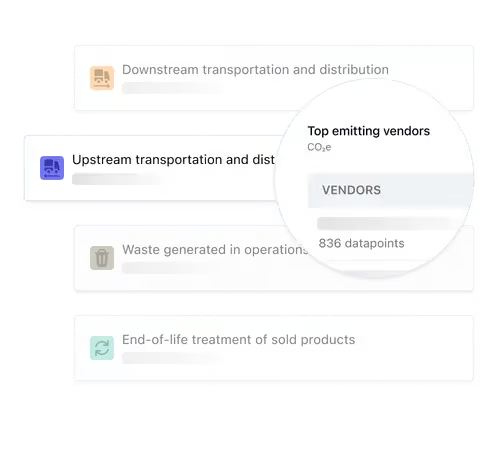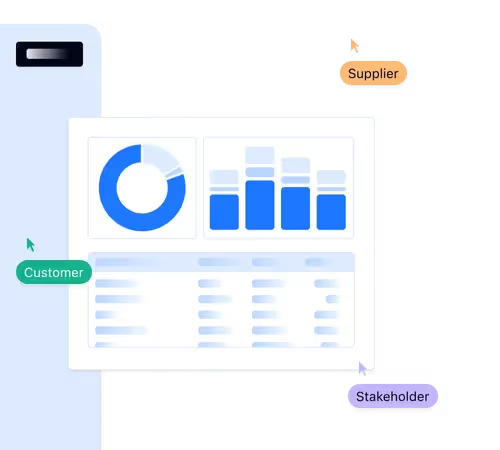Disclaimer: Latest EUDR developments
On 21 October, the European Commission proposed targeted changes to the EU Deforestation Regulation (EUDR). These adjustments aim to make the rollout smoother without changing the regulation’s overall goals.
Key points from the proposal:
We're closely monitoring the development and will update our content accordingly. In the meantime, read the full explainer here.
In corporate sustainability, Scope 3 emissions – that is all indirect emissions from a company’s supply chain – stand out as an area of major concern.
According to the UN Global Compact, these can account for a whopping 70% of a company’s total emissions on average – or simply put, a huge slice of your environmental impact.
This overwhelming percentage highlights why learning how to measure Scope 3 emissions is vital in your company's sustainability journey. The problem? These emissions are notoriously hard to track.
In this blog post, we’ll unpack the different emission sources growing businesses deal with, zoom in on why Scope 3 emissions pose such a challenge, and uncover some cool tech solutions that make tracking emissions a breeze.
Before we dive into the challenges of measuring Scope 3 emissions, let’s quickly recap the different emission types and where they came from.
Established in 1998, the Greenhouse Gas Protocol (GHG Protocol) is a widely recognized international framework for corporate GHG accounting. It’s known as the gold standard for businesses looking to measure, monitor, and report on GHG emissions. It categorizes emissions into three distinct scopes:
Scope 1: Direct emissions
Scope 1 emissions are direct emissions that originate from sources your business owns or controls.
This includes everything your company burns – from oil and natural gas to gasoline, diesel, and even wood. So, think of the fuel to power your buildings, vehicles, or any other company-owned equipment.
Scope 2 emissions come from the energy your company buys to run its operations, usually from a utility company or other supplier. They include emissions generated from purchased electricity, steam, heating, or cooling produced off-site.
These emissions are relatively easy to track thanks to your consumption outlined in your energy bills.
Scope 3 emissions are all the indirect emissions not included in Scope 2. Did you know that they can be up to 11.4 times greater than emissions generated by your own operations?
That’s because they encompass the carbon footprint of your company’s entire value chain. In short: everything it takes to make and consume your product.

The GHG Protocol categorizes them into 15 upstream and downstream sources. Here’s what to take stock of:
Upstream emissions (everything to produce your product):
Downstream emissions (everything to consume your product):
{{product-tour-injectable}}
Despite Scope 3 emissions accounting for nearly three-quarters of a company’s emissions on average – and in sectors like finance, even as high as 99.98% – many challenges still exist when it comes to measuring value chain emissions.
One of the main difficulties is a lack of precise data. Many companies don’t yet have the capability or systems in place to track emissions leading to gaps and inconsistencies.
There’s also a notable lack of personnel with technical expertise in carbon management. This makes it difficult to measure and analyze emissions effectively. Hot tip: Emissions management software like Coolset can help.
Plus, with no standardized methodology for calculating Scope 3 emissions, it can be tough to compare data across different sources and entities.
Let’s explore the four biggest challenges in more detail and offer some handy strategies to address them.
A primary challenge in measuring Scope 3 emissions is that suppliers often lack key emission data. As emissions reporting is just starting to enter the mainstream, many suppliers haven't yet felt enough market pressure to begin gathering insights into their product emissions.
Practical solutions:
Another big hurdle is the absence of a standardized framework for reporting product or service emissions. This causes significant gaps in transparency and accessibility, making it challenging for companies to accurately report on their Scope 3 emissions.
For example, in the US, less than 1% of companies in the financial sector adequately disclosed their Scope 3 emissions in a way that met ISS ESG’s quality control standards.
Practical solutions:
Value chains are inherently complex, especially when your direct suppliers (Tier 1) import materials from others (Tier 2). These multiple layers can obscure the trail of Scope 3 emissions, making it hard to accurately track and quantify your full environmental impact.
Practical solutions:
Services pose a unique challenge when it comes to measuring emissions due to the intangible nature of their output. Unlike products, services lack clear, quantifiable parameters, making it tricky to determine the emissions they generate.
Practical solutions:
With multiple suppliers and partners across your supply chain, measuring Scope 3 emissions on your own can seem overwhelming.
Thankfully, there are many sophisticated emission management tools out there that can help you track, analyze, and reduce emissions effectively.
Platforms like Coolset, for example, use powerful data collection techniques to measure your Scope 1, 2, and 3 emissions according to the GHG Protocol methodology – all while saving you time and resources. They can also ensure your business complies with the latest sustainability requirements and generate reports based on your needs.
Keen to see how it works? Request a free demo and see how Coolset can transform your company’s approach to emissions management today.
Measure Scope 1, 2 and 3 according to the Greenhouse Gas Protocol methodology with Coolset's decarbonization platform.

Measure Scope 1, 2 and 3 according to the Greenhouse Gas Protocol methodology with Coolset's decarbonization platform.
